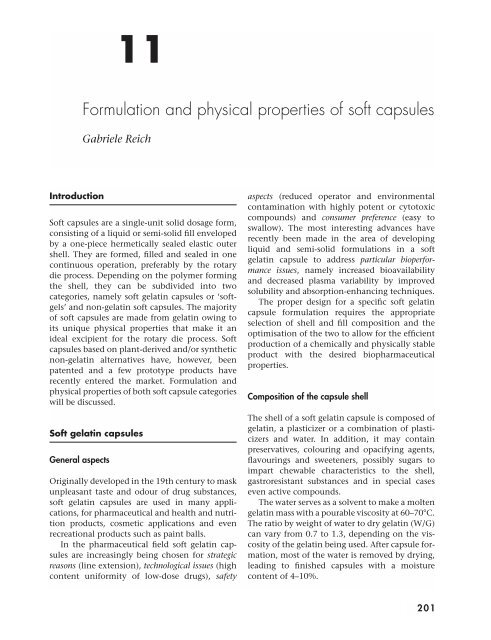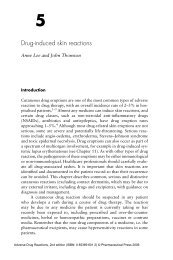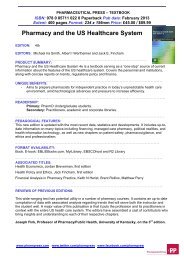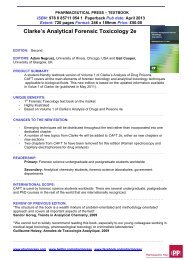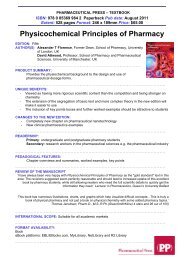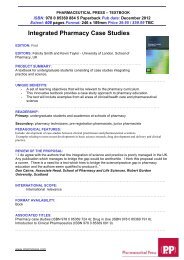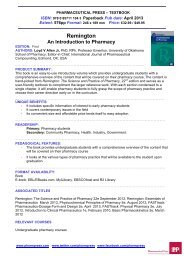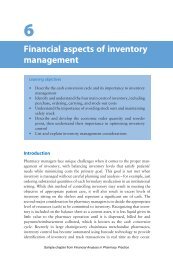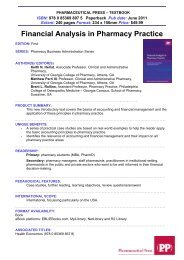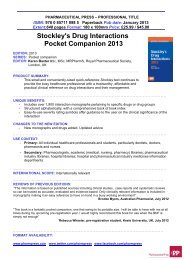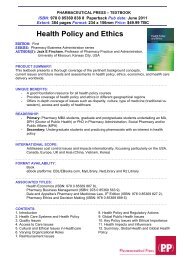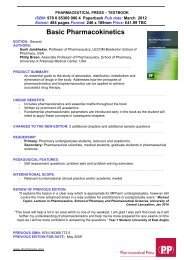11 Chap 11 (bc/d) - Pharmaceutical Press
11 Chap 11 (bc/d) - Pharmaceutical Press
11 Chap 11 (bc/d) - Pharmaceutical Press
Create successful ePaper yourself
Turn your PDF publications into a flip-book with our unique Google optimized e-Paper software.
Introduction<br />
Soft capsules are a single-unit solid dosage form,<br />
consisting of a liquid or semi-solid fill enveloped<br />
by a one-piece hermetically sealed elastic outer<br />
shell. They are formed, filled and sealed in one<br />
continuous operation, preferably by the rotary<br />
die process. Depending on the polymer forming<br />
the shell, they can be subdivided into two<br />
categories, namely soft gelatin capsules or ‘softgels’<br />
and non-gelatin soft capsules. The majority<br />
of soft capsules are made from gelatin owing to<br />
its unique physical properties that make it an<br />
ideal excipient for the rotary die process. Soft<br />
capsules based on plant-derived and/or synthetic<br />
non-gelatin alternatives have, however, been<br />
patented and a few prototype products have<br />
recently entered the market. Formulation and<br />
physical properties of both soft capsule categories<br />
will be discussed.<br />
Soft gelatin capsules<br />
General aspects<br />
<strong>11</strong><br />
Formulation and physical properties of soft capsules<br />
Gabriele Reich<br />
Originally developed in the 19th century to mask<br />
unpleasant taste and odour of drug substances,<br />
soft gelatin capsules are used in many applications,<br />
for pharmaceutical and health and nutrition<br />
products, cosmetic applications and even<br />
recreational products such as paint balls.<br />
In the pharmaceutical field soft gelatin capsules<br />
are increasingly being chosen for strategic<br />
reasons (line extension), technological issues (high<br />
content uniformity of low-dose drugs), safety<br />
aspects (reduced operator and environmental<br />
contamination with highly potent or cytotoxic<br />
compounds) and consumer preference (easy to<br />
swallow). The most interesting advances have<br />
recently been made in the area of developing<br />
liquid and semi-solid formulations in a soft<br />
gelatin capsule to address particular bioperformance<br />
issues, namely increased bioavailability<br />
and decreased plasma variability by improved<br />
solubility and absorption-enhancing techniques.<br />
The proper design for a specific soft gelatin<br />
capsule formulation requires the appropriate<br />
selection of shell and fill composition and the<br />
optimisation of the two to allow for the efficient<br />
production of a chemically and physically stable<br />
product with the desired biopharmaceutical<br />
properties.<br />
Composition of the capsule shell<br />
The shell of a soft gelatin capsule is composed of<br />
gelatin, a plasticizer or a combination of plasticizers<br />
and water. In addition, it may contain<br />
preservatives, colouring and opacifying agents,<br />
flavourings and sweeteners, possibly sugars to<br />
impart chewable characteristics to the shell,<br />
gastroresistant substances and in special cases<br />
even active compounds.<br />
The water serves as a solvent to make a molten<br />
gelatin mass with a pourable viscosity at 60–70°C.<br />
The ratio by weight of water to dry gelatin (W/G)<br />
can vary from 0.7 to 1.3, depending on the viscosity<br />
of the gelatin being used. After capsule formation,<br />
most of the water is removed by drying,<br />
leading to finished capsules with a moisture<br />
content of 4–10%.<br />
201
202 <strong>Chap</strong>ter <strong>11</strong> • Formulation and physical properties of soft capsules<br />
Gelatin<br />
The gelatins used for pharmaceutical or health<br />
and nutrition soft capsule products are described<br />
by the official pharmacopoeias such as USP<br />
(United States Pharmacopoeia), PhEur (European<br />
Pharmacopoeia) etc., or approved by local authorities,<br />
with additional physicochemical specifications<br />
(Babel, 2000). The specifications and<br />
controls for gelatins are discussed in <strong>Chap</strong>ter 2.<br />
For soft capsule production, the pharmacopoeial<br />
specifications generally represent the<br />
minimum requirements. Capsule manufacturers’<br />
specifications are more detailed and<br />
stringent with respect to the performancerelated<br />
physicochemical properties of the<br />
gelatins (Reich and Babel, 2001). This is due to<br />
the fact that these parameters are critical for<br />
economic soft capsule production by the rotary<br />
die process and for the quality of the final<br />
product. Gelatin types and grades that are adequate<br />
for continuous commercial soft capsule<br />
production require the ability to set at a fast rate<br />
to ribbons of defined thickness and reproducible<br />
microstructure and to produce films with a<br />
mechanical strength and elasticity sufficient to<br />
survive all the manipulations on the encapsulation<br />
machine, i.e. to allow the wet films to be<br />
easily removed from the drums, to stretch during<br />
filling, to be sealed at temperatures below the<br />
melting point of the film and to be dried quickly<br />
under ambient conditions to a specified capsule<br />
strength. Moreover, the dissolution characteristics<br />
of the resulting capsules have to fulfil the<br />
pharmacopoeial requirements.<br />
Table <strong>11</strong>.1 Physicochemical properties of pharmacopoeial-grade soft capsule gelatins<br />
Considering these aspects, the technologically<br />
relevant gelatin parameters are gel strength, viscosity<br />
at 60°C and 6– 2<br />
% w/w concentration in<br />
3<br />
water, viscosity breakdown (the impact of temperature<br />
and time on the degradation of gelatin),<br />
melting point, setting point, setting time, particle<br />
size and molecular weight distribution. A<br />
perfect soft capsule gelatin should have the<br />
following specifications:<br />
• Gel strength: 150–200 Bloom, depending on<br />
the gelatin type;<br />
• Viscosity (60°C/6– 2<br />
% w/w in water): 2.8–4.5<br />
3<br />
mPa s, depending on the gelatin type;<br />
• Well-controlled degree of viscosity breakdown;<br />
• Well-defined particle size to allow fast dissolution<br />
and deaeration of the molten mass, even<br />
at high gelatin concentrations;<br />
• A broad molecular weight distribution to<br />
provide a fast setting and the fusion temperature<br />
being well below the melting temperature<br />
of the plasticized wet film.<br />
The main gelatin types and grades used for the<br />
manufacture of soft capsules are listed in Table<br />
<strong>11</strong>.1 together with their physicochemical specifications.<br />
The proper choice of the gelatin type and<br />
grade is related to technological issues, consumer<br />
preference and pricing. For pharmaceutical or<br />
health and nutrition products, medium bloom<br />
limed bone (LB) gelatins, or blends of limed bone<br />
and pigskin (LB/PS) or limed bone, pigskin and<br />
limed hide gelatin (LB/LH/PS) are commonly<br />
used, with a certain preference for LB gelatin in<br />
the United States and for blended gelatins in<br />
Gelatin Raw material Type Bloom (g) Viscosity (mPa s)<br />
(10°C; 6– 2<br />
% w/w)<br />
3<br />
(60°C; 6–2 % w/w)<br />
3<br />
160 LB (= limed bone) Bovine/porcine bone B 155–185 3.4–4.2<br />
160 LH (= limed hide) Bovine hide B 150–170 3.5–4.2<br />
160 LB/LH Blend of bovine/porcine<br />
bone and bovine hide<br />
B 150–170 3.5–4.2<br />
200 AB (= acid bone) Bovine bone A 180–210 2.7–3.2<br />
200 PS (= pigskin) Pigskin A 190–210 2.5–3.1<br />
160 PS/LB/LH Blend of pigskin, bovine/<br />
porcine bone and bovine hide<br />
A/B 145–175 2.7–3.3
Europe. Low-viscosity, high-bloom gelatins such<br />
as a 200 Bloom pigskin (PS) or acid bone (AB)<br />
gelatin are often used for the encapsulation of<br />
hygroscopic formulations and/or water-sensitive<br />
drugs, where standard gelatin formulations have<br />
to be modified to contain less water and dry<br />
faster, thus improving the product stability<br />
during capsule manufacturing. Mixtures of low<br />
(100 Bloom) and medium Bloom (150 Bloom)<br />
gelatins have been proposed for the formulation<br />
of chewable soft capsules (Overholt, 2001) to<br />
achieve the desired mouthfeel and solubility of<br />
the shells, a low stickiness for improved machinability<br />
and sufficient integrity for stable fill<br />
encapsulation.<br />
In addition to the pharmacopoeial grade<br />
gelatin types listed in Table <strong>11</strong>.1, succinylated<br />
pigskin gelatin (Bloom: 190–210 g; viscosity:<br />
3.3–4.1 mPa s) is often used for products with<br />
reactive fill ingredients, such as aldehydes, to<br />
prevent cross-linking of the shell. Gelatins<br />
derived from poultry, fish or other sources have<br />
recently been proposed in the patent literature as<br />
alternatives to gelatin of bovine and porcine<br />
origin. Poultry and fish gelatins have recently<br />
been approved by PhEur.<br />
From a technological point of view, poultry<br />
gelatin is a potential alternative to the conventional<br />
soft capsule gelatins derived from<br />
bovine and porcine origin, since its physicochemical<br />
properties are comparable to those of<br />
pigskin gelatins. In practice, it has not gained<br />
high commercial interest yet because its availability<br />
is limited.<br />
The use of cold- or warm-water fish gelatins for<br />
soft capsule production is limited by the fact that<br />
their gelling, setting and drying properties are<br />
more or less different to those of mammalian<br />
gelatins. Owing to their low degree of proline<br />
hydroxylation, cold-water fish gelatins lack the<br />
gelling and setting attributes that are required to<br />
allow their use in the conventional rotary die<br />
process. Although addition of a setting system,<br />
such as carrageenan, has been described to enable<br />
the adaptation of specific and desired gelling<br />
properties (Scott et al., 1997), this approach has<br />
not yet reached commercial status. Only warmwater<br />
fish gelatins with a somewhat higher<br />
degree of proline hydroxylation, and thus an<br />
intrinsic gelling and setting ability sufficient for<br />
conventional soft capsule production, have been<br />
used for a small number of products. Acceptable<br />
soft capsules can be produced by adjusting the<br />
formulation and process parameters, such as the<br />
production speed in accordance to the reduced<br />
setting rates, the mechanical properties and the<br />
drying characteristics of this gelatin type.<br />
The use of plant-derived genetically engineered<br />
gelatins for soft capsule production is not practicable.<br />
This is mainly due to technological issues,<br />
supply problems, high costs and, for pharmaceutical<br />
products, the regulatory issues. Only<br />
small amounts of gelatins, with gelling and<br />
setting properties and mechanical characteristics<br />
different to mammalian gelatins, are available at<br />
a multiple of the price of conventional gelatins.<br />
Plasticizers<br />
Soft gelatin capsules 203<br />
The formation of a soft capsule requires the use of<br />
a non-volatile plasticizer in addition to water to<br />
guarantee the mechanical stability, i.e. the elasticity<br />
of the capsule shells during and after the<br />
drying process. The additional plasticizer has to<br />
counterbalance the stresses that are induced in<br />
the shrinking capsule shells, as the plasticizing<br />
effect of water in the shells decreases upon drying.<br />
Practically, only a few plasticizers are in use,<br />
namely polyalcohols, which are approved by the<br />
official pharmacopoeias or by local regulatory<br />
authorities. Glycerol (85% and 98% w/w), special<br />
grades of non-crystallising aqueous sorbitol and<br />
sorbitol/sorbitan solutions and combinations of<br />
these are the most used. In addition, propylene<br />
glycol and low molecular weight polyethylene<br />
glycol (PEG 200) have been used.<br />
The type and concentration of plasticizer(s) in<br />
the shell is related to the composition of the fill,<br />
i.e. the possible interactions with the fill, the<br />
capsule size and shape, the end use of the product<br />
and the anticipated storage conditions. The ratio<br />
by weight of dry plasticizer to dry gelatin (P/G)<br />
determines the strength of the shell and usually<br />
varies between 0.3 and 1.0. The choice of the<br />
proper shell formula with respect to the gelatin/<br />
plasticizer combination is crucial to the physical<br />
stability of the capsules, during manufacture<br />
and on storage. A rational shell design therefore<br />
requires analytical tools that allow the performance-related<br />
test parameters to be assessed.
204 <strong>Chap</strong>ter <strong>11</strong> • Formulation and physical properties of soft capsules<br />
Differential scanning calorimetry (DSC) and<br />
dynamic mechanical thermal analysis (DMTA)<br />
have been reported as suitable methods to<br />
monitor phase transitions and elastic moduli<br />
indicating molecular gelatin/plasticizer interactions<br />
and their effect on shell elasticity, i.e. to<br />
evaluate plasticizer effectivity and compatibility<br />
(Reich, 1983, 1994).<br />
An ideal plasticizer should interact with the<br />
gelatin molecules in such a way as to reduce<br />
effectively the glass transition temperature (T g)<br />
of the gelatin shell without inhibiting the formation<br />
of crystallites that stabilise the threedimensional<br />
gel network structure. In addition,<br />
if present in concentrations higher than saturation,<br />
it should be physically embedded in the sol<br />
phase of the gel network to avoid bleeding out<br />
(Reich, 1994).<br />
Glycerol, the most frequently used soft gelatin<br />
capsule plasticizer, combines these advantages of<br />
a high plasticizer effectivity, a sufficient compatibility<br />
and a low volatility with the ability to<br />
interact specifically with the gelatin allowing for<br />
the formation of a stable thermoreversible gel<br />
network. Its plasticizing capability is mainly<br />
resulting from direct interactions with the gelatin<br />
and only slightly from its hygroscopicity allowing<br />
for an additional indirect moisturising effect<br />
(Reich, 1994).<br />
Sorbitol, on the other hand, is an indirect plasticizer,<br />
mainly acting as a moisturising agent with<br />
water being the effective plasticizer. Compared to<br />
glycerol, its direct plasticizing capability is very<br />
much reduced, as indicated by a minor reduction<br />
of the gelatin glass transition temperature.<br />
Gradual differences of various grades of noncrystallising<br />
sorbitol solutions in their plasticizing<br />
capability and their compatibility with gelatin<br />
are the result of differences in the amount of byproducts,<br />
namely hydrogenated oligosaccharides<br />
and sorbitol anhydrides, i.e. sorbitans (Reich,<br />
1996). Only sorbitol grades with a high amount<br />
of sorbitans, such as Anidrisorb, can effectively<br />
replace glycerol owing to a certain direct plasticizing<br />
effect. On the other hand, hydrogenated<br />
oligosaccharides such as maltitol in combination<br />
with glycerol are very effective additives for the<br />
formulation of chewable soft gelatin capsules,<br />
since they augment the taste and chewability and<br />
assist in the rapid dissolution of the shell upon<br />
chewing, thus improving the mouthfeel (Berry<br />
et al., 1988; Montes and Steele, 1999).<br />
Regarding plasticizing capability, propylene<br />
glycol is superior to sorbitol/sorbitan blends and<br />
even to glycerol. However, owing to its high<br />
solvent power for gelatin, it has a slightly negative<br />
effect on the formation of the gel structure<br />
that has to be compensated for by adjusting the<br />
manufacturing parameters at the encapsulation<br />
machine (Reich, 1994). Liquid polyethylene<br />
glycols can only be used in combination with<br />
glycerol or propylene glycol, since their compatibility<br />
with gelatin is limited.<br />
Other additives<br />
In addition to gelatin, the plasticizer(s) and water,<br />
optional components in the capsule shell are<br />
limited in their use. For economic reasons, the<br />
addition of active ingredients in the shell is<br />
usually not recommended and limited to inexpensive<br />
compounds in chewable capsules. The<br />
use of water-insoluble polymers to impart sustained-release<br />
characteristics to the capsules has<br />
failed owing to their limited compatibility with<br />
the gelatin mass (Reich, 1983). Formulations<br />
with gastroresistant enteric soluble polymers are<br />
under development.<br />
Colouring and opacifying agents are used frequently<br />
to give the shells the desired colour and<br />
a proper finish, i.e. to allow the shell to protect<br />
the fill from light and to mask the unpleasant<br />
look of the fill. As a general rule, the colour of the<br />
capsule shell is chosen to be darker than the<br />
colour of the fill. Before a colour is chosen, mixtures<br />
should be checked to ascertain that fading<br />
or darkening of the capsule shells does not occur<br />
on storage, as a result of reactions between the<br />
colouring agent and other components of the<br />
shell or fill.<br />
Fill compositions<br />
Soft gelatin capsules can be used to dispense<br />
active compounds that are formulated as a liquid<br />
or semi-solid solution, suspension or microemulsion<br />
preconcentrate. The formulation of the<br />
fill is individually developed to fulfil the following<br />
requirements:
• to optimise the chemical stability of the active<br />
compound<br />
• to improve bioavailability of the active compound<br />
• to allow for an efficient and safe filling process<br />
• to achieve a physically stable capsule product.<br />
Final product stability is related to shell compatibility<br />
and will be discussed later.<br />
For a soft gelatin capsule-filling operation, the<br />
technologically important factors to bear in mind<br />
are temperature, viscosity and surface activity of<br />
the fill material and, in the case of suspensions,<br />
the particle size of the suspended drug. Liquids or<br />
combinations of liquids for encapsulation must<br />
possess a viscosity sufficient to be precisely dosed<br />
by displacement pumps at a temperature of 35°C<br />
or below and may not show stringing to allow<br />
for a clean break from the dosing nozzle. The<br />
temperature specification is necessary owing to<br />
the sealing conditions, which are usually in the<br />
range of 37 to 40°C. Owing to certain tolerances<br />
of the encapsulation equipment, suspended solids<br />
should have a particle size below 200 µm to<br />
ensure maximum homogeneity of the suspension.<br />
Moreover, the surface-active properties of<br />
the fill, whether a solution or a suspension, may<br />
not interfere with the formation of the seals.<br />
Interestingly, soft gelatin capsule fill formulations<br />
have changed over time from basic<br />
lipophilic to hydrophilic solutions or suspensions<br />
and recently to more complex self-emulsifying<br />
systems. The reason for these developments is<br />
that new chemical entities (NCEs) present increasing<br />
biopharmaceutical formulation demands.<br />
Basic lipophilic solutions or suspensions have<br />
been the traditional and most frequently used soft<br />
gelatin capsule fill formulations in the past. They<br />
have been applied successfully to formulate oily<br />
and lipophilic low melting point drugs such as the<br />
vitamins A, D and E, drugs with unpleasant taste<br />
and/or odour such as the vitamins of the B group<br />
or herbal extracts, drugs with critical stability, i.e.<br />
oxygen- and light-sensitive drugs and low-dose or<br />
highly potent drugs. The vehicles used for this<br />
purpose are lipophilic liquids and semi-solids, and<br />
the optional use of surfactants. The lipophilic<br />
liquids are refined speciality oils such as soya bean<br />
oil, castor oil etc. and/or medium chain triglycerides<br />
(MCT). The semi-solids, acting as viscosity<br />
Soft gelatin capsules 205<br />
modifier for the liquid oils, are hydrogenated<br />
speciality oils or waxes, such as hydrogenated<br />
castor oil or bees wax. Surfactants such as lecithin<br />
may be present to improve the dispersion of suspended<br />
drug particles, thus improving content<br />
uniformity. Antioxidants are usually added to stabilise<br />
oxygen-sensitive drugs. Moreover, impregnation<br />
of solid polymer particles with the drug or<br />
drug coating prior to suspension in the oil formulation<br />
has been reported as a successful means to<br />
improve the content uniformity of low-dose suspended<br />
drugs and further increase chemical<br />
stability of sensitive drugs. Examples are vitamin<br />
B12 (Sanc et al., 2000) and retinol (Rinaldi et al.,<br />
1999).<br />
Hydrophilic soft gelatin capsule fill formulations<br />
are based on polyethylene glycols (PEGs).<br />
Low molecular weight polyethylene glycols are<br />
usually used for liquid solutions, with PEG 400<br />
and PEG 600 being the most frequently used. For<br />
the formulation of semi-solid solutions and suspensions,<br />
the low molecular weight polyethylene<br />
glycols (PEG 300–600) are mixed with high molecular<br />
weight solid polyethylene glycols, such as<br />
PEG 4000–10 000, to increase the viscosity.<br />
PEG-based formulations are often chosen to<br />
address bioavailability concerns, i.e. to improve<br />
the solubility of poorly soluble drugs, or to<br />
dispense low-dose and/or high-potency drugs.<br />
Digoxin (Gardella and Kesler, 1977; Ghirardi<br />
et al., 1977), nifedipin (Radivojevich et al., 1983),<br />
temazepam (Brox, 1983) and ibuprofen (Gullapalli,<br />
2001) are active compounds that have been<br />
successfully formulated as PEG solutions in soft<br />
gelatin capsules.<br />
Complex self-emulsifying lipophilic systems<br />
and microemulsion preconcentrates are additional<br />
approaches that have gained increasing interest<br />
as soft gelatin capsule fill formulations to increase<br />
the bioavailability and/or reduce the plasma variability<br />
of poorly soluble and/or poorly absorbed<br />
drugs (Charman et al., 1992; Amemiya et al., 1998,<br />
1999). These systems are typically composed of a<br />
lipophilic solvent and surfactant(s), and optional<br />
use of co-solvent(s) and/or co-surfactant(s), and<br />
may exert solubilising and absorption-enhancing<br />
effects. On contact with aqueous gastrointestinal<br />
fluids, these formulations spontaneously produce<br />
an emulsion with an average droplet size of less<br />
than 100 nm, thus improving drug delivery.
206 <strong>Chap</strong>ter <strong>11</strong> • Formulation and physical properties of soft capsules<br />
Active compounds that have been successfully<br />
formulated as a microemulsion preconcentrate<br />
in softgels are ciclosporin and the protease<br />
inhibitor ritonavir. A patent has also been filed<br />
for ibuprofen (Rouffer, 2001). Examples of microemulsion<br />
pre-concentrate soft gelatin capsule fill<br />
formulations are given in Table <strong>11</strong>.2, indicating<br />
the use of hydrophilic co-solvents such as ethanol<br />
and propylene glycol.<br />
Formulation strategies<br />
Soft gelatin capsule formulation strategies have<br />
to consider the specific shell/fill interactions that<br />
may occur during manufacture, drying and on<br />
storage and control their rate and extent to<br />
achieve a stable product.<br />
Two major types of interactions have to be distinguished:<br />
• Chemical reactions of fill components with<br />
the gelatin and the plasticizer<br />
• Physical interactions, i.e. migration of fill<br />
components in or through the shell and vice<br />
versa.<br />
Cross-linking of gelatin leading to solubility<br />
problems of the shell is a well-known problem<br />
associated with the encapsulation of drugs containing<br />
reactive groups such as the aldehyde<br />
group. It can be successfully reduced by the use of<br />
succinylated gelatin, an approach that is often<br />
used for health and nutrition products, and in<br />
some countries even for pharmaceutical products.<br />
Esterification and transesterification of drugs<br />
with polyols present another unwanted chemical<br />
reaction that may occur. Since glycerol is more<br />
reactive than other polyols, glycerol-free shell<br />
formulations and/or the addition of polyvinyl<br />
pyrrolidone to the fill (Gullapalli, 2001) are preferred<br />
to reduce this problem.<br />
The rate and extent of physical shell/fill interactions<br />
depend strongly on the qualitative and<br />
quantitative composition of both, the shell and<br />
the fill. As a general rule, the water content of the<br />
fill should not exceed a critical value of about 5%.<br />
Fill formulations simply composed of a lipophilic<br />
drug in a lipophilic oily vehicle do not<br />
interact with the hydrophilic gelatin capsule<br />
shell at any time, i.e. either during production or<br />
on storage. The proper choice of the shell composition<br />
therefore only depends on the stability<br />
of the active ingredient, the capsule size, shape<br />
and end use and the anticipated storage conditions.<br />
For very soft capsules and those stored at<br />
ambient conditions, glycerol is the plasticizer of<br />
choice. For more rigid soft gelatin capsules and<br />
those intended to be used in hot and humid<br />
climates, glycerol/sorbitol blends are preferred.<br />
The latter is also valid for soft capsules containing<br />
oxygen-sensitive compounds in the fill (Hom<br />
et al., 1975; Meinzer, 1988). In any case, the P/G<br />
ratio is adjusted to the size and intended use of<br />
the capsules. To obtain light protection, the shell<br />
Table <strong>11</strong>.2 Examples of microemulsion preconcentrate compositions for soft gelatin capsules<br />
Active ingredient Fill excipients<br />
Ciclosporin Ethanol<br />
Propylene glycol<br />
Mono-, di-, triglycerides from corn (maize) oil<br />
Polyoxyethylene (40) hydrogenated castor oil<br />
DL-alpha-tocopherol<br />
Ritonavir Ethanol<br />
Propylene glycol<br />
Polyoxyethylene (35) castor oil<br />
Polysorbate 80<br />
Polyoxyethylene/glyceryl mono-, di-, tri-alcanoate (C8–C18)<br />
Medium chain triglycerides<br />
Citric acid
can be formulated with pigments such as titanium<br />
dioxide and/or iron oxides.<br />
Compared to lipophilic solutions, fill compositions<br />
with hydrophilic components are more<br />
challenging to encapsulate, since they are prone<br />
to interact with the shell (Armstrong et al., 1984,<br />
1985, 1986). The most critical period for diffusional<br />
exchanges between shell and fill is the<br />
manufacturing process, since the moisture<br />
content of the initial shells before drying is<br />
around 40% and the equilibrium moisture level is<br />
only reached after several days. Thus, during<br />
manufacture and drying, hydrophilic components<br />
of the fill may migrate rapidly into the<br />
shell and vice versa, thereby changing the initial<br />
composition of both, the shell and the fill<br />
(Serajuddin et al., 1986). On storage, these processes<br />
may continue until equilibrium is reached.<br />
As a result, the capsule shells can become brittle<br />
or tacky and the fill formulation may be deteriorated,<br />
either shortly after production or on<br />
storage. To guarantee the stability of the final<br />
product, the initial composition of shell and fill<br />
has to be designed in such a way as to minimise<br />
exchange processes. Several approaches to<br />
demonstrate the proof of this concept will be<br />
discussed as follows.<br />
Hydrophilic and/or hygroscopic drug particles<br />
suspended in an oily vehicle may attract and<br />
retain water from the shell and/or migrate themselves<br />
into the shell. This can lead to stability<br />
problems such as hydrolysis or oxidation of the<br />
active ingredient, to assay failure and/or shell discoloration.<br />
To overcome these problems, the<br />
following solutions have been proposed:<br />
• Use of high-Bloom, low-viscosity pigskin or<br />
acid bone gelatin to reduce the initial water<br />
content in the capsule shell and accelerate the<br />
drying process;<br />
• Replacement of glycerol by glycerol/sorbitol<br />
or sorbitol/sorbitan blends to minimise<br />
diffusion of glycerol-soluble active ingredients<br />
into the shell;<br />
• Coating of drug particles to inhibit the browning<br />
reaction between active ingredients, such<br />
as ascorbic acid and gelatin (Oppenheim and<br />
Truong, 2002).<br />
Considerable difficulties have been encountered<br />
with the design of physically stable and<br />
Soft gelatin capsules 207<br />
durable soft capsules containing liquid polyethylene<br />
glycols (PEG 300–600) as the fill vehicle.<br />
This is owing to the fact that polyethylene glycols<br />
have a high affinity for water, glycerol and even<br />
gelatin, i.e. they have a high tendency to attract<br />
water and glycerol from the shell and may<br />
migrate to a certain extent into the shell. As a<br />
result of these processes, capsules may become<br />
brittle shortly after production or on storage,<br />
especially when exposed to cold temperatures<br />
(Shah et al., 1992). Several approaches have been<br />
reported in the patent literature to provide PEGcontaining<br />
soft capsules, in which the optimum<br />
shell strength and elasticity and the desired constitution<br />
of the fill, adjusted after production,<br />
remain unchanged on storage (Brox, 1983, 1988).<br />
EP 0 121 321 (Brox, 1983) describes the combined<br />
use of glycerol and a sorbitol/sorbitan<br />
blend, namely Anidrisorb 85/70, as shell plasticizers.<br />
At the same time the addition of minor<br />
amounts of glycerol and/or propylene glycol to<br />
the liquid PEG fill is proposed. The combination<br />
of these two strategies prevents capsule shell<br />
embrittlement, since exchange processes between<br />
shell and fill are reduced to a minimum. The tendency<br />
of PEG to migrate into the shell is significantly<br />
reduced owing to the fact that PEG is less<br />
soluble in the sorbitol/sorbitan blend than in glycerol.<br />
On the other hand, the excess of plasticizer<br />
in the fill prevents the glycerol from migrating<br />
from the shell into the fill (Shah et al., 1992; Reich,<br />
1996). US 4 744 988 (Brox, 1988), an extended<br />
version of EP 0 121 321, recommends the selection<br />
of PEG 600 with a higher molecular weight<br />
and a lower hygroscopicity compared to PEG 400<br />
as an additional means of reducing shell/fill interactions<br />
and improving capsule shell elasticity.<br />
Microemulsion preconcentrates, comprising<br />
hydrophilic co-solvents such as propylene glycol<br />
and/or ethanol, in addition to oil(s) and surfactant(s),<br />
are another type of fill composition with<br />
challenging demands on the soft gelatin formulation<br />
concept. The hydrophilic co-solvents are<br />
prone to migrate into the shell, with propylene<br />
glycol softening the shell and ethanol volatilising<br />
through the shell, thereby upsetting the fill<br />
formulation in such a way as to change its solubilising<br />
and/or emulsifying properties.<br />
The problems associated with propylene glycol<br />
may be solved by adjusting the shell formulation
208 <strong>Chap</strong>ter <strong>11</strong> • Formulation and physical properties of soft capsules<br />
in such a way as to reduce the tendency of propylene<br />
glycol to migrate, during production and on<br />
storage, by using it as a plasticizer component in<br />
the shell and adjusting the manufacturing conditions<br />
at the drums to reduce tackiness of the<br />
ribbons (Brox et al., 1993; Woo, 1997). An<br />
additional benefit of this approach is, that the<br />
amount of water required for dissolving and<br />
melting the gelatin may be reduced owing to the<br />
lower viscosity of propylene glycol compared to<br />
glycerol and sorbitol solutions, thus reducing the<br />
overall water exchange between shell and fill.<br />
The problems associated with the use of a<br />
volatile solvent such as ethanol are more difficult<br />
to solve. To prevent volatilisation of ethanol, the<br />
finished capsules have to be enclosed in a solventtight<br />
packaging material such as an aluminium<br />
blister. Moreover, replacement of glycerol by<br />
higher polyols such as xylitol, sorbitol, sorbitol/<br />
sorbitan blends and/or hydrogenated starch<br />
hydrolysates has been reported as an effective<br />
means of reducing the rate and extent of ethanol<br />
diffusion into the shell (Reich, 1996; Moreton and<br />
Armstrong, 1998). In certain cases, however, both<br />
approaches may not be sufficient to prevent fill<br />
deterioration, since ethanol diffusion cannot be<br />
fully prevented. Thus, for a microemulsion preconcentrate<br />
formulation that is very sensitive to<br />
the co-solvent concentration, the only way to<br />
overcome the problem at present, is the use of a<br />
co-solvent other than ethanol, that is not volatile<br />
and does not show any diffusion into the capsule<br />
shell. For ciclosporin microemulsion preconcentrate<br />
soft capsules, such approaches have been<br />
filed in two patents, namely a European Patent<br />
Application (Woo, 1995) describing the use of<br />
dimethylisosorbide and a US Patent Application<br />
(Shin et al., 2000) that describes the use of a<br />
microemulsion preconcentrate containing a<br />
lipophilic instead of a hydrophilic co-solvent.<br />
Post-treatments and coatings<br />
Soft gelatin capsules may be post-treated after production<br />
or coated to improve product stability, to<br />
modify the dissolution rate and to enable enteric<br />
capsules to be produced. Several patents have<br />
been filed describing the use of protective coatings<br />
to overcome the stability problems of soft<br />
capsules arising from the hygroscopic nature and<br />
heat sensitivity of the soft capsule shell. However,<br />
most of these attempts have failed in practice,<br />
since coating of soft capsules is not an easy task.<br />
The low surface roughness of soft capsule shells<br />
and the intrinsic insolubility of the shell components<br />
in organic solvents means that coatings<br />
applied as an organic solution usually do not<br />
adhere properly to the capsules, resulting in<br />
onion-like coatings of layers peeling off immediately<br />
after drying or on storage. Aqueous coatings,<br />
on the other hand, may result in capsule swelling,<br />
softening and/or sticking together, since water is<br />
acting as a plasticizer for the gelatin capsule shells.<br />
To balance the two extremes, emulsion-based<br />
formulations or solutions in a mixture of water<br />
and alcohol have been recommended (Osterwald<br />
et al., 1982). The technological approach of choice<br />
for soft capsules to be coated is using the fluidisedbed<br />
air-suspension technique.<br />
Capsules with modified dissolution characteristics,<br />
such as gastroresistant enteric soft gelatin<br />
capsules, have been described in the scientific<br />
and patent literature and can be achieved by<br />
adding gastroresistant, enteric-soluble polymers<br />
to the gelatin mass prior to capsule formation, or<br />
by aldehyde post-treatment or enteric coating of<br />
the dried capsules. All three attempts have their<br />
specific difficulties. For soft gelatin capsules produced<br />
by the rotary die process, the last two<br />
approaches are in practical use.<br />
Aldehyde post-treatment of soft gelatin capsules<br />
has been known for many years as a popular<br />
means to reduce their dissolution rate, i.e. the<br />
capsules take a long time to dissolve and have left<br />
the stomach before this occurs. Formaldehyde<br />
has been described to cross-link effectively soft<br />
capsules to render them gastroresistant. Since<br />
safety questions have been raised about the<br />
presence of trace amounts of formaldehyde in<br />
foods and pharmaceuticals, the use of aldehydes<br />
without health concerns such as aldoses have<br />
been claimed in a patent (Fischer, 1986) and are<br />
actually used. The major disadvantage of any<br />
aldehyde treatment of soft gelatin capsules is that<br />
cross-linking can continue on storage. Alternatively,<br />
soft gelatin capsules may be coated with a<br />
gastroresistant, enteric-soluble polymer. Owing<br />
to the aforementioned difficulties associated with<br />
organic and aqueous soft capsule coating, a
protective su<strong>bc</strong>oat is usually applied as an alcoholic<br />
solution prior to the application of the<br />
gastroresistant, enteric polymer layer (Virgilio<br />
and Matthews, 1989).<br />
Non-gelatin soft capsules<br />
Traditionally, gelatin has been used almost<br />
exclusively as shell-forming material of soft capsules.<br />
This is due to its legal status and its unique<br />
physicochemical properties, namely its oxygen<br />
impermeability and the combination of filmforming<br />
capability and thermoreversible sol/gel<br />
formation, that favour its use for the industrial<br />
soft capsule production especially in the rotary<br />
die process.<br />
Despite these great advantages, which have<br />
been described in detail in the section above on<br />
‘Soft gelatin capsules’, gelatin has several drawbacks<br />
that limit its use for soft capsules:<br />
• The animal source of gelatin can be a problem<br />
for certain consumers such as vegetarians or<br />
vegans and religious or ethnic groups (Jews,<br />
Muslims, Hindus, etc.) who observe dietary<br />
laws that forbid the use of certain animal<br />
products.<br />
• Since unmodified gelatin is prone to crosslinking<br />
when in contact with aldehydes, solubility<br />
problems might be expected with certain<br />
fill formulations.<br />
• Transparent low-colour capsules are difficult<br />
to produce owing to the effect of the intrinsic<br />
Maillard reaction on gelatin colour.<br />
• The temperature and moisture sensitivity of<br />
gelatin-based soft capsules is an issue that<br />
complicates the use of soft gelatin capsules in<br />
very hot and humid regions and requires<br />
special packaging and storage conditions to<br />
ensure product stability.<br />
• For low-price health and nutrition products,<br />
pricing of commercially available gelatin might<br />
be an additional problem.<br />
To address these concerns, there has been a<br />
great interest in the soft capsule industry in<br />
looking for gelatin substitutes. Indeed, several<br />
concepts based on synthetic polymers and/or<br />
plant-derived hydrocolloids have been described<br />
Non-gelatin soft capsules 209<br />
in the patent literature. However, only few have<br />
gained commercial interest. This is due to the fact<br />
that a change in the capsule shell polymer<br />
material requires more than just overcoming<br />
the aforementioned shortcomings of gelatin. It<br />
requires both legal approval and machinability,<br />
i.e. either to mimic most of the physicochemical<br />
gelatin characteristics that are important for<br />
rotary die soft capsule production with some<br />
adjustments of the production equipment for the<br />
new material characteristics or to use a completely<br />
redesigned machinery.<br />
To date, three non-gelatin soft capsule concepts<br />
with different process adjustments have<br />
reached prototype status: two are based on plantderived<br />
hydrocolloids (Draper et al., 1999; Menard<br />
et al., 1999), the third is based on a synthetic<br />
polymer (Brown, 1996).<br />
WO 0 103 677 (Draper et al., 1999) describes<br />
the use of a combination of iota carrageenan<br />
(12–24% w/w of dry shell) and modified starch,<br />
namely hydroxypropyl starch (30–60% w/w of<br />
dry shell), as a gelatin substitute. Both components<br />
are accepted as food additives with E<br />
numbers, thus allowing their use in health and<br />
nutrition products. Hydroxypropyl starch is also<br />
approved as a pharmaceutical excipient. The<br />
combination of the two hydrocolloids leads to a<br />
synergistic interaction that produces a gel<br />
network, which is suitable for soft capsule production<br />
using the rotary die process. It can be<br />
formulated with conventional plasticizers such as<br />
glycerol, sorbitol, etc. (10–60% w/w of dry shell)<br />
and water to form a molten mass that can be<br />
extruded to set within less than 20 s producing<br />
mechanically strong, elastic films on temperature-controlled<br />
casting drums. Sealing may be<br />
performed at temperatures between 25 and 80°C,<br />
by a fusion process comparable to the one<br />
observed with soft gelatin capsules. After drying,<br />
mechanically strong and highly elastic products<br />
can be achieved.<br />
Prototype capsules with lipophilic fill formulations<br />
are shiny with a high appearance stability<br />
on storage. The capsule shells do not show crosslinking<br />
and exhibit a greater mechanical stability<br />
than soft gelatin shells when exposed to elevated<br />
humidity and temperature, i.e. even under hot<br />
and humid storage conditions they may not<br />
become sticky. Formulation approaches with
210 <strong>Chap</strong>ter <strong>11</strong> • Formulation and physical properties of soft capsules<br />
hydrophilic fills are expected to be as challenging<br />
as for soft gelatin capsules. Oxygen permeability<br />
is comparable to gelatin-based shells. The dissolution<br />
mechanism is completely different to the<br />
one of a soft gelatin capsule. On contact with an<br />
enzyme-free aqueous medium at 37°C, the<br />
capsule shell only swells, at a rate and to an<br />
extent depending on the type and concentration<br />
of electrolytes present. The capsule content may<br />
be released when the shell bursts at its point of<br />
lowest resistance, i.e. at the seams. Under in vivo<br />
conditions, capsule shell dissolution may be<br />
induced by enzymatic degradation.<br />
WO 0 137 817 (Menard et al., 1999) describes<br />
the formation of soft capsules from a potato<br />
starch (45–80% w/w), with a specific molecular<br />
weight distribution and amylopectin content,<br />
together with a conventional plasticizer such as<br />
glycerol (12% w/w), a glidant and a disintegrant.<br />
Soft capsule production may be performed<br />
with a rotary die machine with nearly water-free<br />
formulations that are processed by hot melt<br />
extrusion. A narrow production window and the<br />
use of a high molecular weight amorphous starch<br />
with a high amylopectin content (50% w/w) are<br />
necessary for the formation of acceptable capsules.<br />
From the regulatory point of view, starch-based<br />
soft capsules are a low-price alternative to soft<br />
gelatin capsules, appropriate for pharmaceutical<br />
and health and nutrition products. Moisture<br />
sensitivity and fill compatibility of the capsule<br />
shells are comparable to soft gelatin capsules, with<br />
the exception that cross-linking is not a problem.<br />
Oxygen permeability is expected to be a little<br />
higher compared to soft gelatin capsules (Reich,<br />
unpublished results). Shell dissolution requires<br />
enzymatic degradation by amylases; on contact<br />
with amylase-free aqueous media at 37°C, the<br />
capsules release their content only by swellinginduced<br />
disintegration. The addition of calcium<br />
carbonate is one option to enhance capsule disintegration<br />
further.<br />
The visual appearance, the seam quality, and<br />
the long-term stability of the finished product of<br />
the prototype starch capsules cannot compete<br />
with soft gelatin capsules. This is due to the structural<br />
rearrangements within the capsule shells<br />
associated with the tendency of starch to retrograde<br />
on storage, in some instances leading to a<br />
subsequent plasticizer syneresis (Reich, unpublished<br />
results).<br />
WO 9 755 37 (Brown, 1996) describes the<br />
preferable use of polyvinyl alcohol (PVA) and<br />
optional use of some other materials, all being<br />
film-forming polymers that lack the gelling properties<br />
that are necessary for soft capsule production<br />
using the conventional rotary die process.<br />
The invention therefore provides the use of preformed<br />
rolls of nearly water-free plasticized films<br />
that may be fed to a rotary die encapsulation unit<br />
for soft capsule production. To render the film<br />
material more flexible and to assist seam formation<br />
at temperatures depending on the film<br />
composition, the films are partially spraysolvated<br />
prior to encapsulation.<br />
PVA films according to this invention may be<br />
composed of 70–75% w/w PVA, 10–15% w/w glycerol<br />
and 5–10% w/w starch, with a sealing temperature<br />
of 140–180°C, depending on the degree<br />
of solvation. PVA as an optional gelatin substitute<br />
has the advantage of being less hygroscopic, thus<br />
leading to soft capsule shells that are less sensitive<br />
to moisture than soft gelatin capsule shells. Moreover,<br />
the capsules are readily water soluble with<br />
no cross-linking tendency. However, prototype<br />
capsules lack the shiny and smooth surface<br />
appearance and the seam quality of conventional<br />
soft gelatin capsules. In addition, the regulatory<br />
issues and the formulation of hydrophilic fills are<br />
problems that have to be solved.<br />
To summarise, it may be concluded that none<br />
of the gelatin-free soft capsule concepts is fully<br />
developed yet. Nevertheless, soft capsules based<br />
on plant-derived or synthetic polymers are an<br />
interesting line extension to soft gelatin capsules<br />
with the potential to gain a market share for<br />
certain niche products.<br />
Analytical approaches for<br />
soft capsule testing<br />
Finished soft capsule products, either gelatinor<br />
non-gelatin-based, are routinely specified by<br />
strength values, drug content, dissolution properties<br />
and in some cases by their water content.<br />
Moreover, they are checked for long-term<br />
stability under ICH (International Conference on
Harmonisation) conditions. The official tests for<br />
soft capsules are discussed in <strong>Chap</strong>ter 13.<br />
Drug content is determined by either HPLC<br />
(high performance liquid chromatography) or any<br />
other appropriate QC (quality control) method.<br />
Dissolution properties are checked according to<br />
the pharmacopoeial requirements, with a two-tier<br />
test being approved for products with reduced<br />
solubility. Water content may be assessed by Karl<br />
Fischer titration.<br />
Strength measurements (‘hardness’ measurements)<br />
are performed using a commercially available<br />
tester (Barreiss Hardness Tester) in which<br />
the capsules are compressed to a certain extent<br />
between a measuring detector and a slowly<br />
moving plate. The counter force exerted by the<br />
capsules is displayed in newtons. Under these test<br />
conditions, an optimum strength range is specified<br />
by the manufacturer for each product.<br />
Strength values above or below this specified<br />
range are indicative of insufficient flexibility or<br />
softening, respectively.<br />
Recently, the use of conventional or modulated<br />
DSC has been proposed as an additional<br />
analytical tool to determine performance-related<br />
microstructural features of soft capsule shells,<br />
such as the glass transition temperature (T g),<br />
the melting temperature (T m) and the melting<br />
enthalpy (H m) (Reich, 1994, 1995, 1996; Nazzal<br />
and Wang, 2001). T g, T m and H m are important<br />
parameters for monitoring process- and storageinduced<br />
structural changes within a capsule shell<br />
and have been successfully applied to the design<br />
and optimisation of soft capsules, i.e. to evaluate<br />
plasticizer effectivity and compatibility, and<br />
shell/ fill interactions.<br />
Near infrared (NIR) spectroscopy is another<br />
modern analytical technique with great potential<br />
for soft capsule specification and efficient stability<br />
testing (Reich, 2000). NIR is a fast and noninvasive<br />
spectroscopic method that allows for<br />
simultaneous evaluation of soft capsule identity,<br />
drug and water content (Buice et al., 1995) and in<br />
some cases film coat thickness of the finished<br />
product directly after production. In addition,<br />
storage-induced chemical and physical changes<br />
in both the shell and the fill can be assessed, thus<br />
allowing for an early and non-destructive<br />
detection of stability problems such as moisture<br />
changes and shell/fill interactions leading to<br />
cross-linking, softening or hardening of the<br />
capsule shell (Gold et al., 1997; Reich, 2000).<br />
References<br />
References 2<strong>11</strong><br />
Amemiya, T., Mizuno, S., Yuasa, H. and Watanabe, J.<br />
(1998). Development of emulsion type new vehicle<br />
for soft gelatin capsule. I. Selection of surfactants for<br />
development of new vehicle and its physicochemical<br />
properties. Chem. Pharm. Bull., 46, 309–313.<br />
Amemiya, T., Mizuno, S., Yuasa, H. and Watanabe, J.<br />
(1999). Emulsion type new vehicle for soft gelatin<br />
capsule available for pre-clinical and clinical trials:<br />
effects of PEG 6000 and PVP K30 on physicochemical<br />
stability of new vehicle. Chem. Pharm. Bull., 47,<br />
492–497.<br />
Armstrong, N. A., James, K. C. and Pugh, K. L. (1984).<br />
Drug migration into soft gelatine capsule shells and<br />
its effect on in-vitro availability. J. Pharm. Pharmacol.,<br />
36, 361–365.<br />
Armstrong, N. A., James, K. C., Collett, D. and Thomas,<br />
M. (1985). Solute migration from oily solutions into<br />
glycerol–gelatin mixtures. Drug Dev. Ind. Pharm., <strong>11</strong>,<br />
1859–1868.<br />
Armstrong, N. A., Gebre-Mariam, T. and James, K. C.<br />
(1986). An apparatus for investigating drug migration<br />
into gelatin capsule shells. Int. J. Pharm., 34, 125–129.<br />
Babel, W. (2000). Gelatine in pharmaceutical applications.<br />
Pharmaceut. Manuf. Packing Sourcer, 6, 63–66.<br />
Berry, I. R., Borkan, L. and Shah, D. (1988). Chewable,<br />
edible soft gelatin capsule. European Patent Application<br />
0 374 359.<br />
Brown, M. D. (1996). Improvements in or relating to<br />
encapsulation. International Patent Application<br />
WO 9 735 537.<br />
Brox, W. (1983). <strong>Pharmaceutical</strong> compositions. EP<br />
0121 321.<br />
Brox, W. (1988). Soft gelatin capsules and methods for<br />
their production. US Patent 4 744 988.<br />
Brox, W., Zande, H. and Meinzer, A. (1993). Soft gelatin<br />
capsule manufacture. EP 0 649 651.<br />
Buice Jr., R. G., Gold, T. B., Lodder, R. A. and Digenis, G.<br />
A. (1995). Determination of moisture in intact<br />
gelatin capsules by near-infrared spectrophotometry.<br />
Pharm. Res., 12, 161–163.<br />
Charman S. A., Charman, W. N., Rogge, M. C., Wilson,<br />
T. D., Dutko, F. J. and Pouton, C. W. (1992). Selfemulsifying<br />
drug delivery systems: formulation and<br />
biopharmaceutical evaluation of an investigational<br />
lipophilic compound. Pharm. Res., 9, 87–93.
212 <strong>Chap</strong>ter <strong>11</strong> • Formulation and physical properties of soft capsules<br />
Draper, P. R., Tanner, K. E., Getz, J. J., Burnett, S. and<br />
Youngblood, E. (1999). Film forming compositions<br />
comprising modified starches and iota-carrageenan<br />
and methods for manufacturing soft capsules using<br />
same. International Patent Application WO<br />
0 103 677.<br />
Fischer, G. (1986). Gelatin capsules for the controlled<br />
release of the active agent, and process for their<br />
preparation. EP 0 240 581.<br />
Gardella, L. A. and Kesler, H. (1977). Gelatin-encapsulated<br />
digoxin solutions and method of preparing the<br />
same. US Patent 4 002 718.<br />
Ghirardi, P., Catenazzo, G., Mantero, O., Merotti, G. C.<br />
and Marzo, A. (1977). Bioavailability of digoxin in a<br />
new soluble pharmaceutical formulation in capsules.<br />
J. Pharm. Sci., 66, 267–269.<br />
Gold, Th. B., Buice Jr., R. G., Lodder, R. A. and Digenis,<br />
G. A. (1997). Determination of extent of crosslinking<br />
in hard gelatin capsules by near-infrared<br />
spectrophotometry. Pharm. Res., 14, 1046–1050.<br />
Gullapalli, R. P. (2001). Ibuprofen-containing softgels.<br />
US Patent 6 251 426.<br />
Hom F. S., Veresh, S. A. and Ebert, W.R. (1975). Soft<br />
gelatin capsules. II. Oxygen permeability study of<br />
capsule shells. J. Pharm. Sci., 64, 851–857.<br />
Meinzer, A. (1988). Studies on Oxygen Permeability of Soft<br />
Gelatin Capsules. PhD Thesis, Freiburg i.Br., Germany.<br />
Menard, R., Tomka, I., Engel, W. D. and Brocker, E.<br />
(1999). Process to manufacture starch-containing<br />
shaped bodies, mass containing homogenized<br />
starch and device to manufacture soft capsules.<br />
International Patent Application WO 0 137 817.<br />
Montes, R. and Steele, D. R. (1999). Chewable softgel<br />
oral hygiene product. US Patent 5 948 388.<br />
Moreton, R. C. and Armstrong, N. A. (1998). The effect of<br />
film composition on the diffusion of ethanol through<br />
soft gelatin films. Int. J. Pharm., 161, 123–131.<br />
Nazzal, S. and Wang, Y. (2001). Characterization of soft<br />
gelatin capsules by thermal analysis. Int. J. Pharm.,<br />
230, 35–45.<br />
Oppenheim, R. C. and Truong, H. C. (2002). Discoloration-resistant<br />
vitamin composition. US Patent<br />
Application 2002 004 069.<br />
Osterwald, H., Bauer, K. H., Jäger, K. F. and Reich, G.<br />
(1982), Verfahren und Lösungen zum Beschichten<br />
von Gelatinekapseln. DE 3 243 331.<br />
Overholt, S. M. (2001). Chewable soft capsules. US<br />
Patent 6 258 380.<br />
Radivojevich, F., Joss, H. and Dvorsky, S. (1983). Therapeutic<br />
coronary composition in the form of soft<br />
gelatine capsules. EP 0 143 857.<br />
Reich, G. (1983). Soft Gelatin Capsules: Effect of Gelatin<br />
Gel Structure on Thermal, Mechanical and Biopharmaceutical<br />
Properties. PhD Thesis, Freiburg i.Br., Germany.<br />
Reich, G. (1994). Action and optimization of plasticizers<br />
in soft gelatin capsules. Pharm. Ind., 56, 915–920.<br />
Reich, G. (1995). Effect of drying conditions on structure<br />
and properties of gelatin capsules: studies with<br />
gelatin films. Pharm. Ind., 57, 63–67.<br />
Reich, G. (1996). Effect of sorbitol specification on<br />
structure and properties of soft gelatin capsules.<br />
Pharm. Ind., 58, 941–946.<br />
Reich, G. (2000). Monitoring structural changes in hard<br />
and soft gelatin films and capsules using NIR transmission<br />
and reflectance spectroscopy. Proceedings<br />
3rd World Meeting APV/APGI, Berlin, 3/6 April 2000,<br />
507–508.<br />
Reich, G. and Babel, W. (2001). Performance of different<br />
types of pharmaceutical grade soft capsule gelatins.<br />
AAPS Annual Meeting/<strong>Pharmaceutical</strong> Science Supplement,<br />
W4323.<br />
Rinaldi, M. A., Tutschek, P. C. and Saxena, S. J. (1999).<br />
Softgel formulation containing retinol. US Patent<br />
5891 470.<br />
Rouffer, M. T. (2001). Self-emulsifying ibuprofen solution<br />
and soft gelatin capsule for use therewith. US<br />
Patent 6 221 391.<br />
Sanc, Y., Ito, H. and Enomoto, I. (2000). Soft capsule<br />
including vitamin B12. Japan Patent 2000 095 676.<br />
Scott, R., He, X. and Cade, D. (1997). Gelatine compositions.<br />
WO 9 933 924.<br />
Serajuddin, A.T., Sheen, P.C. and Augustine, M.A.<br />
(1986). Water migration from soft gelatin capsule<br />
shell to fill material and its effect on drug solubility.<br />
J. Pharm. Sci., 75, 62–64.<br />
Shah, N. H., Stiel, D., Infeld, M. H., Railkar, A. S., Malick,<br />
A. W. and Patrawala, M. (1992). Elasticity of soft<br />
gelatin capsules containing polyethylene glycol 400<br />
– quantitation and resolution. Pharm. Technol., 3,<br />
126–131.<br />
Shin, H. J., Choi, N. H., Kim, J. W., Yang, S. G. and<br />
Hong, C. I. (2000). Cyclosporin-containing microemulsion<br />
preconcentrate composition. US Patent<br />
6063 762.<br />
Virgilic, G. and Matthews, J. W. (1989). Process for<br />
coating gelatin capsules. US Patent 4 816 259.<br />
Woo, J. S. (1995). Cyclosporin soft capsule composition.<br />
EP 0 650 721.<br />
Woo, J. S. (1997). Cyclosporin-containing soft capsule<br />
preparations. International Patent WO 9 748 410.


